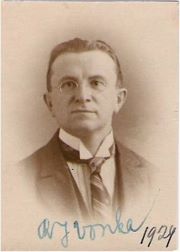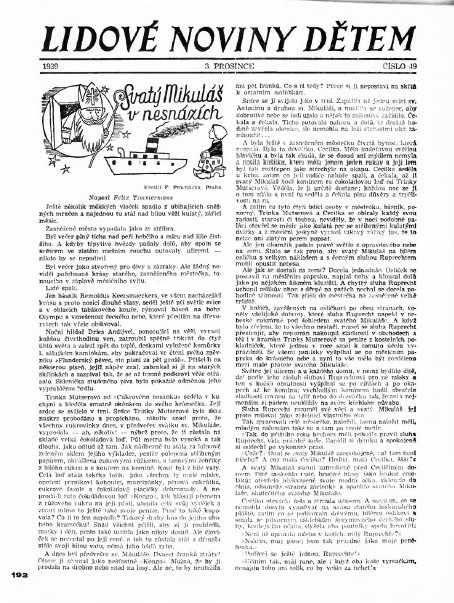Felix Timmermans & Margriet de Moor
In this page, we will focus on the Czech translations of works by Felix Timmermans, certainly the most successful Flemish writer of the period between both World Wars, and by Margriet de Moor, one of the most successful women writers of the last decades.
Felix Timmermans in Czech Language

The Flemish writer Felix Timmermans (1886-1947) was by far the most translated into German. It is remarkable that Czech is in second place together with French (see Durnez 2000: 795-800). A total of seventeen works by Timmermans were translated into Czech. It concerns novels and novellas as well as stories and fairy tales. Sixteen of these were first published in the first half of the twentieth century (between 1922 and 1943), only Adriaan Brouwer was introduced in the Czech Republic in 1970. It is interesting that the majority of the novels were reprinted, which is quite unusual for Dutch literature, at least in the Czech Republic. It is also remarkable that several works are translated into Czech more than once, another phenomenon that is unusual for Dutch-language literature in the Czech Republic.
Rudolf J. Vonka

Timmermans' Czech reception was mainly provided by two translators. The first is Rudolf Jordán Vonka (1877-1964), together with Lída Faltová (1890-1944) the first Czech translator to focus on Dutch. During his career, Vonka worked at the Ministry of Foreign Affairs in Prague and at the Czechoslovak embassy in The Hague. He was interested in a large number of scientific disciplines, for example in medicine, lexicography and comeniology, the study of the well-known pedagogue Comenius. He has translated a total of ten Dutch-language titles, including five novels by Timmermans, all of which have been published in book form: Pallieter, Het Kindeken Jezus in Vlaanderen, Pieter Breughel, Boerenpsalm and De Familie Hernat. The quality of Vonka's translations can be described as controversial. Several Dutch scholars, such as Olga Krijtová, Wilken Engelbrecht and Veronika Horáčková, have noted that Vonka deviated greatly from the original and added whole paragraphs to it. Despite this, he made a major contribution to the Czech reception of Timmermans, as Engelbrecht also notes: 'Thanks to this, [...] Felix Timmermans became a household name for the Czech reader' (Engelbrecht 2021: 159).
Otto F. Babler
The second translator is Otto Franjo Babler (1901-1984) who was born in Bosnia and later lived in Olomouc. Babler has a huge amount of translations to his credit. There are about 4,000 translations from 20 different languages, the majority from Polish, French, English, German, Russian and several South Slavic languages. As far as Timmermans is concerned, Babler has mainly translated his stories and novellas.
The Reception of Timmermans in Czech Language

The Saint Nicolas Story "De Nood van Sintrklaas" by Timmermans in czech translation (Lidové noviny, 1939)
It can be concluded that Timmermans' works in the Czech Republic were mainly published by prestigious publishers and that usually renowned personalities (in addition to translators also illustrators) were involved. Timmermans, for example, appeared at the unique publishing house Družstevní práce. Timmermans' stories generally appeared in newspapers and magazines that had a large readership, for example Lidové noviny. Somewhat on the periphery were translations of works with religious themes published by relatively closed Christian circles.
It is also characteristic of Timmermans' reception in the Czech Republic that it was influenced by ideological tendencies. During the independent Czechoslovak republic, his works were allowed to be published without restrictions. This period can therefore be described as the heyday of Timmermans in the Czech Republic. The great popularity of Timmermans in the Czech Republic can be explained by the fact that his works are mainly classified as rural literature, a genre that was already established in the Czech Republic at that time.
Surprisingly, Timmermans was also allowed to appear in the Protectorate without greater restrictions. This may, in the first place, be due to the fact that Timmermans' works - as most Flemish rural novels, other examples were works of the writers Stijn Streuvels, August Thiry, Gerard Walschap and Ernest Claes - were associated with Blut-und-Boden literature and that Timmermans occupied a special place in Nazi Germany in promoting Flemish writers in German translation. Secondly, this may be due to the fact that in the Protectorate the literature of enemy countries (including France and Great Britain) was banned. That is why some publishers turned to Scandinavian and Dutch literature.
After the communist takeover, Timmermans became a banned author. On the list of unwanted literature, all his books are labelled 'ruralism'. According to the official explanation, ruralist works were inspired by fascism and glorified the power of nature. The real reason why Timmermans was banned is probably because of the Catholic themes which was often read by religious people and inhabitants of the countryside, i.e. by circles that were generally critical of the communist party.
Critics and Cinema
Timmermans was mostly positively reviewed by Czech critics. Most critics praise the vitalism and life optimism with which his works are interspersed. They also often glorify the beauty of Flemish nature and associate Timmermans' works with Flemish and Dutch painting. However, critical voices are also emerging. They accuse Timmermans that his texts are too simple, naive and superficial.
The good reception of Timmermans in the Czech environment is also evidenced by the fact that adaptations of his works are known. There are two pieces of music that are based on words from Pallieter. In 2011, at the Prague International Film Festival Febiofest, a modern adaptation of En waar de sterre bleef stille staan was shown.
Margriet de Moor

While Felix Timmermans enjoyed the popularity of Czech readers especially in the first half of the 20th century, the Dutch author Margriet de Moor (*1941) has aroused the interest of Czech readers over the past thirty years. The number of De Moors works is quite high compared to other contemporary Dutch writers. Five novels by De Moor were published in Czech translation, all translated by Magda de Bruin Hüblová (*1959). Magda de Bruin Hüblová was born in Prague. In 1982 she moved to Amsterdam, where she lives to this day. Together with her husband, the Dutch Slavist and translator of Czech literature, Edgar de Bruin, she runs the Pluh literary agency. In addition, she is the head of the Dutch and Flemish section of the literary internet magazine iLiteratura.cz. She translated into Czech Tommy Wieringa, Saskia de Coster or Willem Frederik Hermans among others.
It is remarkable that the most Czech translations of Margriet de Moor were published in Czech only a few years after the Dutch original as Veronika ter Harmsel Havlíková stated (2004: 30). The impetus for publishing Margriet de Moor in Czech came from the literary festival Svět knihy (Book World) in Prague. In 1999 the festival focused on Dutch-language literature. Dutch literature was promoted at the festival with the personal participation of Arnon Grunberg, Cees Nooteboom and Margriet de Moor (Engelbrecht et al. 2015: 524). As a result, interest in these authors has increased among Czech publishers.
The first novel by De Moor published in Czech was Eerst grijs dan wit dan blauw (Šedá, modrá, bílá). In 2000, it was published by the publishing house Mladá fronta. Another book followed in 2003: Kreutzersonate (Kreutzerova sonáta). This time it was published by another publishing house, namely Paseka. The third novel by De Moor, which was published in Czech, is De Verdronkene (Utonulá). In 2007, it was also published by Paseka. In 2011, the novel De schilder en het meisje (Malíř a dívka) followed. This time, the publishing house Pistorius & Olšanská published it. The last Czech translation of De Moor so far, namely De virtuoos (Virtuos), was published in this publishing house too. It was in 2013.
Several reviews of De Moors novels have also been published in Czech. Many of these reviews have been published in major literary magazines, be it Tvar, Host or Literární noviny. Czech reviews of the novels are mostly positive. Reviewers appreciate, for example, the fact that De Moor, in her historical novels, transcends the boundaries of this genre and conveys a timeless message to her readers.
References
Durnez, Gaston (2000). Felix Timmermans: een biografie. Tielt: Lannoo
Engelbrecht, Wilken, Lianne Barnards, Lucie Smolka Fruhwirtová, Martina Vitáčková & Eva Brázdová Toufarová (2015). Dějiny nizozemské a vlámské literatury. Praha: Academia
